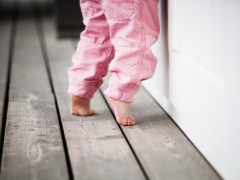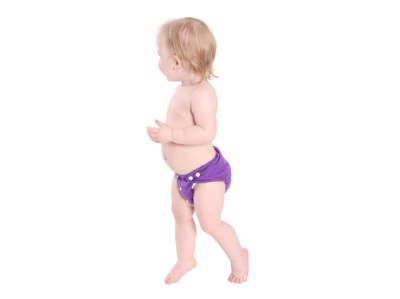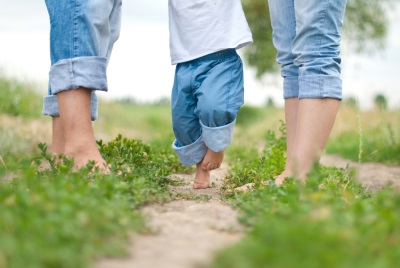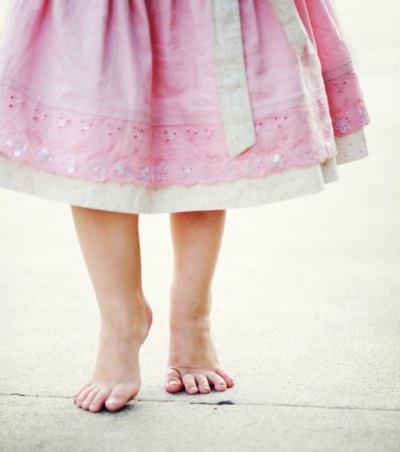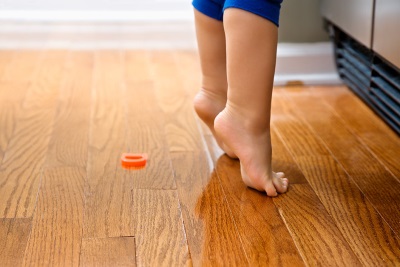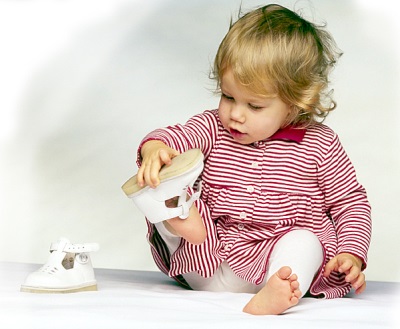Why does a child walk on socks and what to do?
If a child while walking does not fully fall on the whole foot, but moves on toes, many parents begin to worry about this. Can walking on tiptoe be a symptom of some dangerous disease, up to what age such movement is considered normal and what should parents do if the baby has been walking on socks for a long time?
The reasons
Up to 3 years
The kid, who is just learning the skill of walking, quite often gets into socks. And if the child is not yet three years old, there is no need to worry.
For a child at 1 year old and at 1.5 years old, episodic walking on tiptoes is absolutely normal.
If the mother took the baby by the hand for 2 years, and he began to walk on socks, there is no reason to worry either. After all, until the baby is 3 years old, he is still learning how to walk and improve this skill. Many kids try to walk in different ways until they learn to do it right. And one of such ways has the right to be walking on socks.
Most often, the child becomes when walking on socks because of the uneven tension of the muscles of the legs, which is called muscular dystonia.
Other reasons for walking tiptoe are:
- Frequent stay in the walker. The crumb learns to take the first steps on the fingers and then learn to set the feet differently to him is difficult.
- High activity. The kid is full of energy and runs straight on his toes.
- Thirst for knowledge and curiosity. A crumb strives to grow faster and periodically becomes socks.
- Imitation mom who walks on heels. Also, the child can see the ballerinas and try to walk like them.
- Cerebral palsy. In the case of such a reason for walking on socks, the child will have other symptoms of this disease.
- Birth injury. It can affect the work of the baby’s brain, but, as a rule, this cause is identified and treated long before the first steps.
- Pyramidal failure. This is the name of the disruption in the work of that part of the nervous system that is responsible for the movement of the body.
- Psychological problems. When something in the baby’s family does not get along, the crumb feels internal discomfort and begins to walk on tiptoes subconsciously, as if sneaking.
Older children
If a child at 4 years old, 5 years old or older continues to walk on socks, the cause may be a neurological disease.
In addition, children older than three years can tiptoe for the following reasons:
- Trying to attract attention.
- Copy someone.
- Trying to look taller.
It happens that a child rises on socks when he reaches out to something, does not want to step on or freeze. These reasons should not cause concern.
What to do?
Parents who are worried about the constant walking of their baby on their socks should turn to a neurologist. The specialist will determine if the crumbs of other symptoms that indicate neurological disorders, as well as, if necessary, schedule examinations. During the visit to the doctor, be prepared to answer the following questions:
- What was the current of pregnancy and whether there were problems during childbirth?
- Did the baby have oxygen deficiency during fetal development and the birth process?
- Does the baby get on socks while walking constantly or sporadically? In what circumstances does he begin to walk in this way?
- Are there other symptoms besides walking on tiptoes that alert you?
If walking on tiptoe is associated with dystonia of muscles, the child needs to be able to move more - stand, climb, crawl, walk on all fours, walk like a duck, on inclined and soft surfaces, barefoot.
Also, depending on the reason for walking on socks, a child may be advised:
- Physiotherapy.
- Electrophoresis.
- Herbal baths (use chamomile, a succession, motherwort, lavender).
- Medical gymnastics.
- Paraffin boots (the procedure has its contraindications, so only a doctor should prescribe it).
- Swimming.
- Proper selection of orthopedic shoes (note the presence of a rigid backdrop and fixing the rise of the foot with velcro or lacing).
Do I need a massage and how to do it?
Most babies whose mothers complain about walking on tiptoes are recommended to have a massage, which can be performed both in the hospital and at home. During the massage, the mother should:
- "Draw" on the foot of the crumbs with the thumb of the "eight".
- Stroking baby's legs, ranging from fingertips to hips.
- Thumb and index fingers to knead the calf muscles of the baby.
- Move the foot away from you, and then towards yourself.
- Roll the baby on the fitball so that the baby paces the ball.
- Shake baby's feet.
- Separately massage each finger.
- To pokolachivat baby foot with the back of your fingers.
Opinion E. Komarovsky
The famous pediatrician calls walking on tiptoe the norm for children under two or three years old and argues that almost all toddlers pass through the walk in a similar way when they master the skill of walking, especially if the child often happens in walkers. A popular doctor notes that close attention to this symptom is paid due to its connection with some dangerous neurological diseases. However, in situations where walking on socks is not accompanied by symptoms of impairment of the nervous system, according to Komarovsky, nothing is required.
For more on this, see the transfer of Dr. Komarovsky.
